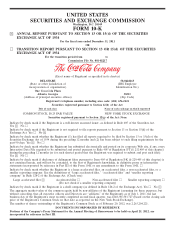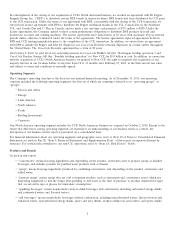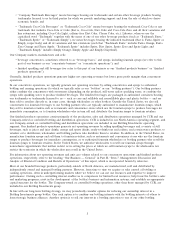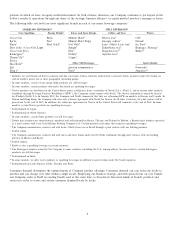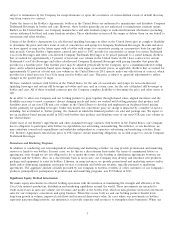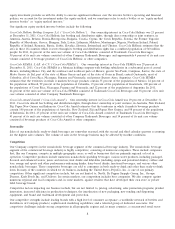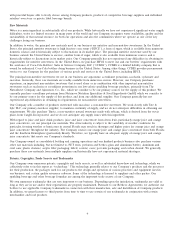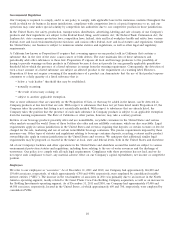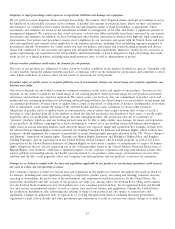Coca Cola 2011 Annual Report Download - page 10
Download and view the complete annual report
Please find page 10 of the 2011 Coca Cola annual report below. You can navigate through the pages in the report by either clicking on the pages listed below, or by using the keyword search tool below to find specific information within the annual report.equity investment provides us with the ability to exercise significant influence over the investee bottler’s operating and financial
policies, we account for the investment under the equity method, and we sometimes refer to such a bottler as an ‘‘equity method
investee bottler’’ or ‘‘equity method investee.’’
Our significant equity method investee bottlers include the following:
Coca-Cola Hellenic Bottling Company S.A. (‘‘Coca-Cola Hellenic’’). Our ownership interest in Coca-Cola Hellenic was 23 percent
at December 31, 2011. Coca-Cola Hellenic has bottling and distribution rights, through direct ownership or joint ventures, in
Armenia, Austria, Belarus, Bosnia-Herzegovina, Bulgaria, Croatia, Cyprus, the Czech Republic, Estonia, the Former Yugoslav
Republic of Macedonia, Greece, Hungary, Italy, Latvia, Lithuania, Moldova, Montenegro, Nigeria, Northern Ireland, Poland,
Republic of Ireland, Romania, Russia, Serbia, Slovakia, Slovenia, Switzerland and Ukraine. Coca-Cola Hellenic estimates that the
area in these 28 countries which it serves through its bottling and distribution rights has a combined population of 560 million
people. In 2011, 46 percent of the unit case volume of Coca-Cola Hellenic consisted of Trademark Coca-Cola Beverages;
50 percent of its unit case volume consisted of other Company Trademark Beverages; and approximately 4 percent of its unit case
volume consisted of beverage products of Coca-Cola Hellenic or other companies.
Coca-Cola FEMSA, S.A.B. de C.V. (‘‘Coca-Cola FEMSA’’). Our ownership interest in Coca-Cola FEMSA was 29 percent at
December 31, 2011. Coca-Cola FEMSA is a Mexican holding company with bottling subsidiaries in a substantial part of central
Mexico, including Mexico City and the southeast and northeast parts of Mexico; greater S˜
ao Paulo, Campinas, Santos, the state of
Matto Grosso do Sul, part of the state of Minas Gerais and part of the state of Goias in Brazil; central Guatemala; most of
Colombia; all of Costa Rica, Nicaragua, Panama and Venezuela; and greater Buenos Aires, Argentina. Coca-Cola FEMSA
estimates that the territories in which it markets beverage products contain 55 percent of the population of Mexico, 22 percent of
the population of Brazil, 99 percent of the population of Colombia, 35 percent of the population of Guatemala, 100 percent of
the populations of Costa Rica, Nicaragua, Panama and Venezuela, and 32 percent of the population of Argentina. In 2011,
62 percent of the unit case volume of Coca-Cola FEMSA consisted of Trademark Coca-Cola Beverages and 38 percent of its unit
case volume consisted of other Company Trademark Beverages.
Coca-Cola Amatil Limited (‘‘Coca-Cola Amatil’’). Our ownership interest in Coca-Cola Amatil was 29 percent at December 31,
2011. Coca-Cola Amatil has bottling and distribution rights, through direct ownership or joint ventures, in Australia, New Zealand,
Fiji, Papua New Guinea and Indonesia. Coca-Cola Amatil estimates that the territories in which it markets beverage products
contain 100 percent of the populations of Australia, New Zealand, Fiji and Papua New Guinea, and 98 percent of the population
of Indonesia. In 2011, 45 percent of the unit case volume of Coca-Cola Amatil consisted of Trademark Coca-Cola Beverages;
41 percent of its unit case volume consisted of other Company Trademark Beverages; and 14 percent of its unit case volume
consisted of beverage products of Coca-Cola Amatil or other companies.
Seasonality
Sales of our nonalcoholic ready-to-drink beverages are somewhat seasonal, with the second and third calendar quarters accounting
for the highest sales volumes. The volume of sales in the beverage business may be affected by weather conditions.
Competition
Our Company competes in the nonalcoholic beverage segment of the commercial beverage industry. The nonalcoholic beverage
segment of the commercial beverage industry is highly competitive, consisting of numerous companies. These include companies
that, like our Company, compete in multiple geographic areas, as well as businesses that are primarily regional or local in
operation. Competitive products include numerous nonalcoholic sparkling beverages; various water products, including packaged,
flavored and enhanced waters; juices and nectars; fruit drinks and dilutables (including syrups and powdered drinks); coffees and
teas; energy and sports and other performance-enhancing drinks; dairy-based drinks; functional beverages; and various other
nonalcoholic beverages. These competitive beverages are sold to consumers in both ready-to-drink and other than ready-to-drink
form. In many of the countries in which we do business, including the United States, PepsiCo, Inc., is one of our primary
competitors. Other significant competitors include, but are not limited to, Nestl´
e, Dr Pepper Snapple Group, Inc., Groupe
Danone, Kraft Foods Inc. and Unilever. In certain markets, our competition includes beer companies. We also compete against
numerous regional and local companies and, in some markets, against retailers that have developed their own store or private
label beverage brands.
Competitive factors impacting our business include, but are not limited to, pricing, advertising, sales promotion programs, product
innovation, increased efficiency in production techniques, the introduction of new packaging, new vending and dispensing
equipment, and brand and trademark development and protection.
Our competitive strengths include leading brands with a high level of consumer acceptance; a worldwide network of bottlers and
distributors of Company products; sophisticated marketing capabilities; and a talented group of dedicated associates. Our
competitive challenges include strong competition in all geographic regions and, in many countries, a concentrated retail sector
8

